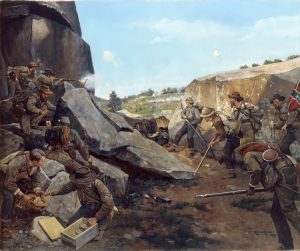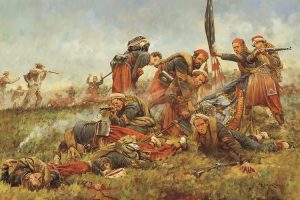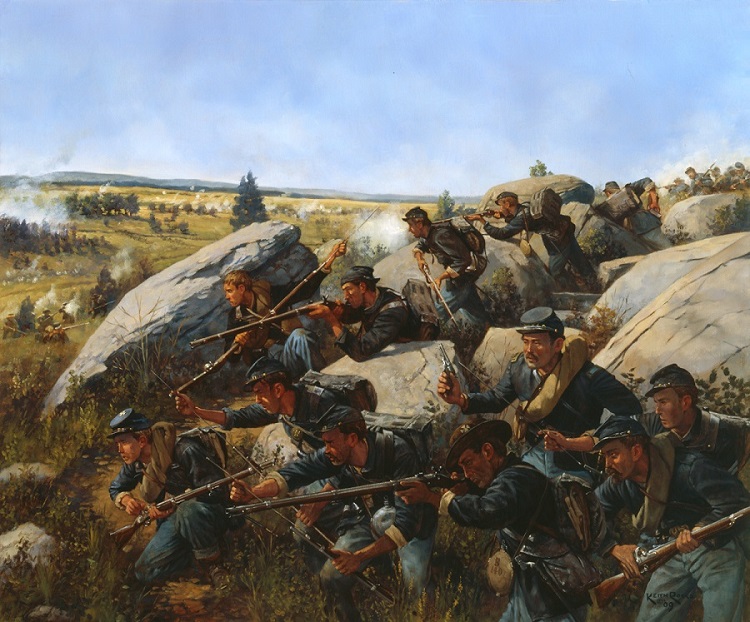The 140th New York on Little Round Top
Description
50 signed and numbered prints
Late in the afternoon of July 2, 1863, as the Confederates of James Longstreet’s Corps attacked Union General Dan Sickles’ advanced line on the Union left, General Gouverneur K. Warren, chief Engineer of the Army of the Potomac was sent to reconnoiter the Union left flank. Riding to the summit of Little Round Top, he gained a panoramic view of the battle, seeing Confederates swarming against Sickles, but also massing for an attack that would overrun the Devil’s Den as well as the Round Tops, thereby seizing the key to the battlefield.
Little Round Top was only occupied by a small party of signalmen. Warren immediately sent an aide for reinforcements and then descended the hill to divert whatever troops he could find to hasten them to the rocky knoll.
Fortunately, Warren encountered Brigadier General Stephen H. Weed’s Brigade, which he himself had commanded earlier in the war. Warren quieted the cheering men and approached Colonel Patrick O’Rorke, acting as brigade commander. “Paddy, give me a regiment,” he implored. Warren overrode O’Rorke’s objections, and assumed responsibility for re-directing O’Rorke’s men. The 140th New York, hastened off to aid the already beleaguered Union forces on Little Round Top. Warren’s quick action sent troops to the summit of Little Round Top just in time to meet the Confederate assault.
On Little Round Top, the Confederate attack was lapping around the Union right flank, where the undermanned 16th Michigan was stationed with the 44th New York to its left. Colonel Strong Vincent directed the 140th New York into the maelstrom of the Confederate attack. “Down this way boys,” yelled O’Rorke, waving his sword over his head as he led the men down the slope into the Confederates of the 4th and 5th Texas and 48th Alabama.”We went in with a cheer,” wrote one soldier, “The Rebels looked at us . . . then they gave us a murderous volley . . . Our men fell at every step they took.” As Vincent urged on his men, he was mortally wounded. Charging with unloaded rifles, the New Yorkers were able to blunt the Confederate assault driving back the 48th Alabama and the 4th Texas, thereby solidifying the Union right flank. Success came at a human cost, however. Among the fallen in the 140th New York was a 19 year old Lieutenant Charles Kline, (pictured in the painting in the right foreground, wielding a pistol) wounded in the right thigh. Kline died several days later in a field hospital.
The emergency on this part of the battlefield had passed. Fighting on the reverse slope of Little Round Top also resulted in a Federal success. The bloody fighting on Little Round Top gave the Union army undisputed possession of this important elevation, but only by the narrowest of margins.
For the rest of the evening, the New Yorkers took position behind the rocks and boulders to snipe at Rebels in the Devil’s Den and the Valley of Death.
Additional information
| Medium | |
|---|---|
| Size | 12" x 16", 20" x 24" |
| Type |
Related products
-

5th New Hampshire Officer- 1862
$125.00 Add to cart -

The Devil’s Den
$220.00 – $345.00 Select options This product has multiple variants. The options may be chosen on the product page -

Confederate Reconnaissance
$220.00 Add to cart -

Save the Colors
Read more

